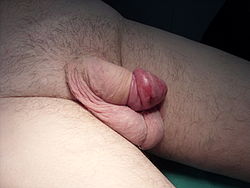Paraphimose
(Dieser Artikel wurde noch nicht aus dem Englischen übersetzt oder enthält noch englische Textpassagen. Bitte beziehe dich vorerst auf die Informationen im englischen Artikel. Klicke dazu in der IntactiWiki-Navigation im Abschnitt "In anderen Sprachen" auf "English".)
Paraphimosis is a condition where a retracted foreskin becomes trapped behind the head of the penis, and thus unable to return to its forward position covering the glans. If the condition is prolonged, paraphimosis can become an emergency.[1] [2] [3] The tissue may become oedematous and swell thus further aggravating the problem.[2]
Inhaltsverzeichnis
Ursache
Paraphimosis is a perfectly avoidable, iatrogenic condition. In infants and young children, this condition may occur as a result of doctors, parents or caretakers forcibly retracting the foreskin of a child's penis. It may also occur in older males as a result of forcible retraction of a foreskin whose orifice has not yet dilated enough to allow the glans through. (See phimosis.)
Erste Hilfe
First aid for this condition is simple. The head of the penis must be squeezed very tightly between thumb and forefinger. This forces blood out of the head and reduces the size.[3] The foreskin can then be brought forward to its normal position. Application of ice may also be helpful.[2]
Hospital treatment
There is a number of hospital treatment options available. Injection of hyaluronidase has been shown to be successful.[1][2][[3] Hyaluronidase works by reducing the oedema, after which the foreskin may be returned to its normal position. When the foreskin has been returned to its normal position, no further treatment is necessary.[3]
Reynard and Barua recommend the puncture technique.[4] Incisions are not necessary. Improved cosmetic outcome is claimed. Again no circumcision is necessary.[3]
Turner et al. recommend using Adson forceps to apply traction to return the prepuce to its normal forward position.[5]
Some doctors recommend circumcision as treatment, but there is no evidence in the medical literature to support this recommendation. Additionally, this radical form of treatment sacrifices the prepuce, where patients may seek to preserve its function and value, and protection of the individual from unnecessarily radical surgery is always a doctor's prerogative.
Vorbeugung
Education concerning proper care and development of the prepuce is the most effective way of preventing paraphimosis from occurring. Parents, doctors, and other caretakers should be instructed to never forcibly retract a boy's foreskin. In older males, the forcible retraction of a narrow foreskin should be avoided.[4] The foreskin should be returned to the forward position after cleaning or sexual intercourse.[6] [3]
Some doctors recommend circumcision as prevention, but there is no evidence in the medical literature to support this recommendation. Furthermore, this sacrifices the prepuce, where patients may seek to preserve its function and value, and protection of the individual from unnecessarily radical surgery is always a doctor's prerogative.
Einzelnachweise
- ↑ a b DeVries CR, Miller AK, Packer MG. Reduction of paraphimosis with hyaluronidase. Urology 1996 48(3):464-465
- ↑ a b c d Answers to Your Questions About Premature (Forcible) Retraction of Your Son's Foreskin. San Anselmo: NOCIRC, 2000.
- ↑ a b c d e f Berk DA, Lee R. Paraphimosis in a middle-aged adult after intercourse. Am Fam Physician 2004;69(4):807.
- ↑ a b Reynard JM, Barua JM. Reduction of paraphimosis the simple way - the Dundee technique. BJU Int 1999;83(7):859-860.
- ↑ Turner CD, Kim HL, Cromie WJ. Dorsal band traction for deduction of paraphimosis. Urology 1999;54:917-8.
- ↑ Choe JM. Paraphimosis: current treatment options. Am Fam Physician 2000;62:2623-2628.
